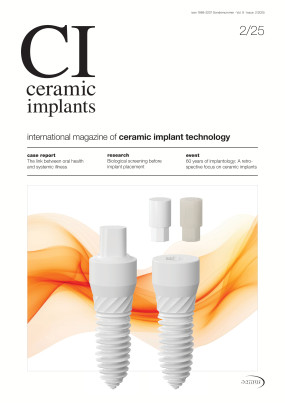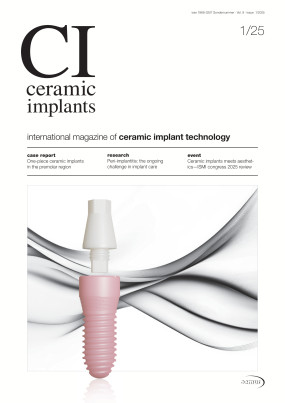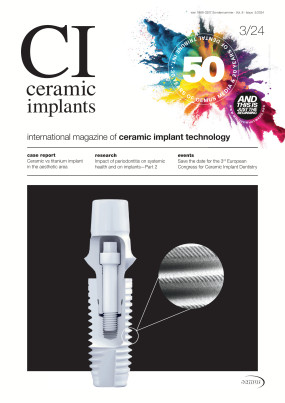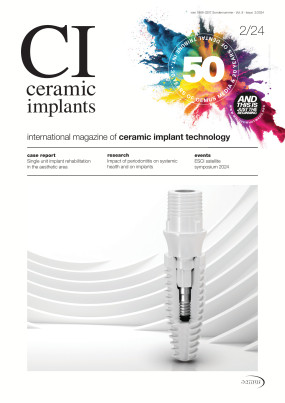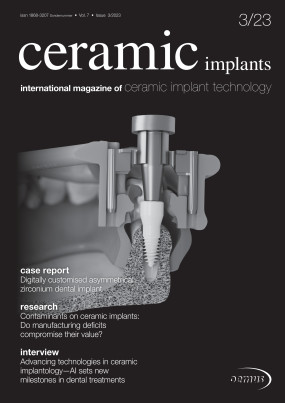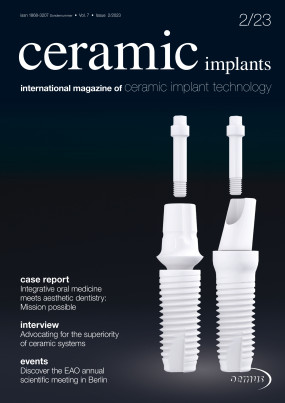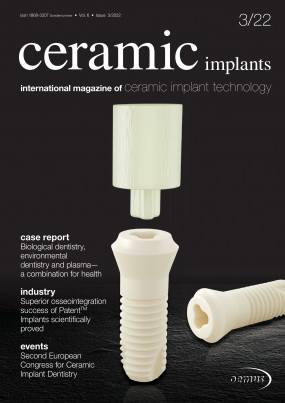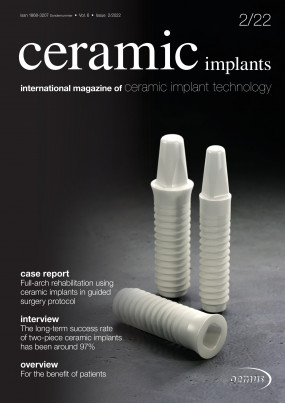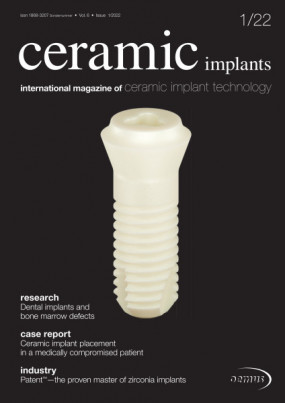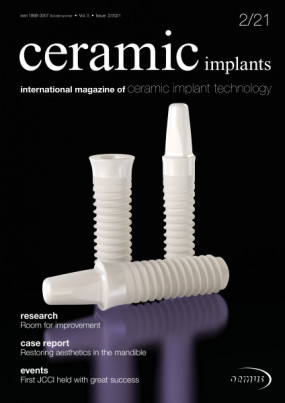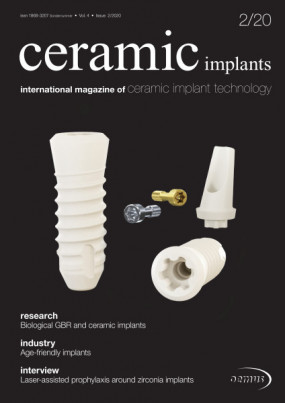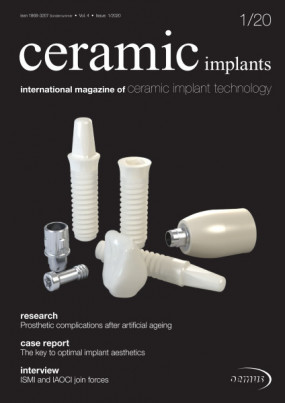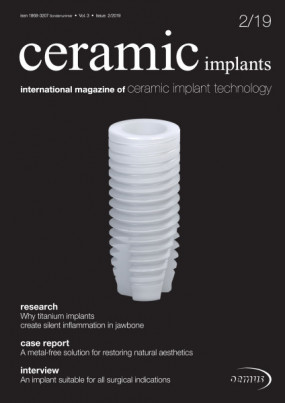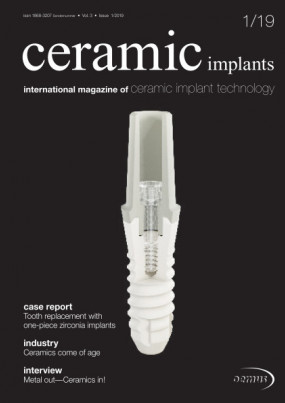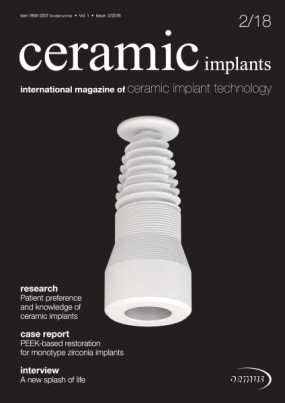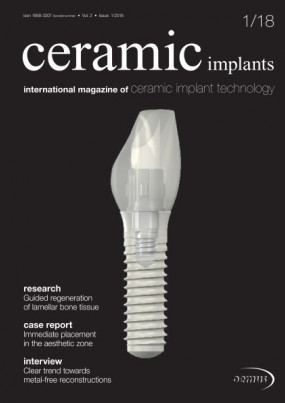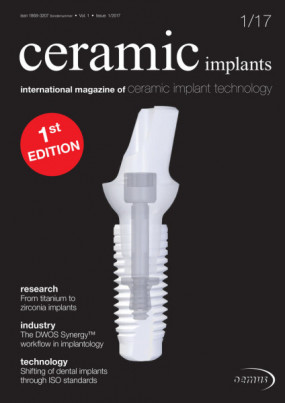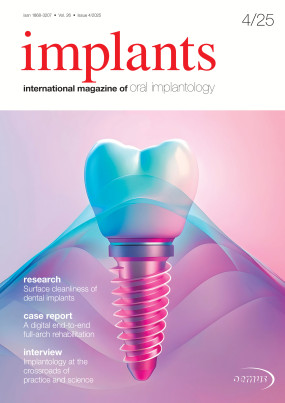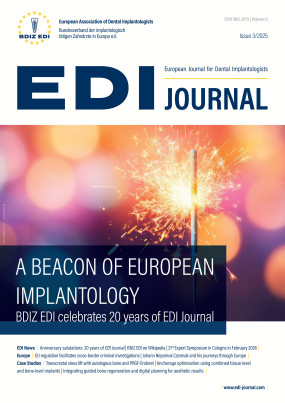Inhaltsverzeichnis
3
Today, patients have significant access to information and may come into the dental office with in-depth questions or recommendations regarding their treatment. Responding to these may require dentists to learn more about new procedures or technologies, looking at the scientific evidence with a critical eye. Regarding dental implantology, for example, there is market demand for a broader range of indications and greater prosthetic flexibility. Now new reliable long-term data on the clinical success of two-piece ceramic implants has made a fundamental contribution to evidence-based implantology, heralding a paradigm shift in the scientific discussion about ceramic implant systems. Many readers will be learning about this evidence for the first time in this issue of ceramic implants...
6
Dental implants and bone marrow defects—Evaluation of bone quality by intra-oral ultrasonography
Dr Johann Lechner, Germany
In ceramic implants—international magazine of ceramic implant technology issue 2/2021, I discussed the objective validation of bone quality before implant placement in light of establishing whether the level of mineralisation in the jawbone is sufficient to osseointegrate an implant without any issues and to keep it secure in a stable bone bed for a long time or whether the implant is connected to a bone marrow defect.1 In this current article, I would like to consider two questions relevant to the situation after implant insertion: ...
12
Ceramic dental implants in clinical use—Evaluation of the ESCI scientific survey
Dr Jens Tartsch, Switzerland
In modern dental implantology, ceramic implants offer a supplement to the treatment spectrum with titanium implants. Increasing interest in ceramic implants owing to their biological advantages can be observed not only on the part of health-conscious patients but also in the dental profession. Promising short- and medium-term data on the successful use of ceramic implants is available. Nevertheless, the topic of ceramic implants is still controversial in part because of the lack of long-term data...
14
While dental implants are becoming a standard treatment for tooth loss, there is emerging but steadily growing patient demand for reliable, metal-free, naturallooking ceramic implants. This demand is particularly pronounced not only in patients with metal sensitivity but also in those who would like to have highly aesthetic restorations. I personally have experienced that the latter group are patients who have had restorations before, done extensive research about the topic online and come to my practice specifically asking for ceramic implants. The challenge I face is that those patients would like to have a reliable ceramic implant and expect successful treatment outcomes irrespective of their age, lifestyle or medical history...
18
Single-tooth replacement with ceramic implants—A case series
Professors Curd Bollen & Paul Tipton, UK
Dental implants have helped to improve quality of life for our patients. The material of choice for implants remains Type IV titanium, whose mechanical and biological properties have been proved.1 Yet, this material is not exempt from complications. Firstly, these metallic implants show aesthetic limitations when used in the anterior region, especially in patients with a thin gingival biotype. Examples are the possible appearance of a metallic margin in case of gingival recession and a greyish discoloration due to translucency of the peri-implant mucosa.2, 3 Secondly, studies have reported immunological reactions to titanium particles, leading to biological complications.4 Others have demonstrated allergic reactions to titanium, reporting a prevalence of 0.6%.5 ...
24
Extraction of tooth is carried out for numerous reasons, including caries, fractures, periodontal problems, prosthetic purposes, orthodontic, and widespread external or internal root resorption. Root resorption (pathological) has a multifactorial etiology, although many aspects remain unclear, and can lead to loss of tooth structure. The use of dental implants is a reliable treatment option for replacing missing or hopeless teeth, and the satisfactory and predictable outcomes reported by several implant research studies have supported the huge development and standardisation of oral implantology.
28
The use of zirconia as a material for dental implants and prostheses, in conjunction with newly developed materials and CAD/CAM technology, undoubtedly represents a fascinating opportunity to restore the teeth of our patients. As with any new technology, increasingly precise manufacturing techniques are bringing about a change in indications. Today, it is possible to realise customfabricated CAD/CAM zirconia bars on zirconia implants...
30
Ceramic implants account for 50% of implants we use
An interview with Prof. Michael Gahlert & Dr Stefan Röhling, Germany
Experts in the field of two-piece ceramic implants, Prof. Michael Gahlert and Dr Stefan Röhling together run an oral surgery practice in Munich. In this interview with ceramic implants, they discuss the advantages of ceramic implants and provide a scientific update on the topic. In addition, the implantologists, being pioneers in the field of modern ceramic implants, share their experience of zirconia implants and consider the significance for clinicians of the statement by the European Society for Ceramic Implantology on the clinical application of two-piece zirconia implants and what the future holds for ceramic implantology...
34
In response to the desire for a broader range of indications and greater prosthetic flexibility, two-piece ceramic implant systems are increasingly finding their way on to the market. In the past, however, numerous two-piece ceramic implant systems have come to the market that presented major drawbacks regarding failing osseointegration or high fracture rates. With the Patent™ Dental Implant System, Zircon Medical Management has adopted a revolutionary, 20-year-old technology that promises to eliminate these drawbacks of conventional ceramic implant systems...
36
Second-generation ceramic implant—Successional whiteSKY zirconia implant from bredent medical
Author
The contemporary zirconia implant is truly comparable to titanium and has no treatment limitations. This makes it a reliable alternative for patients with metal allergies, those wishing to lead a metal-free lifestyle and those needing implants in the aesthetic zone to ensure that dark shading does not affect the aesthetic outcome of the restoration...
